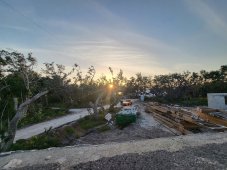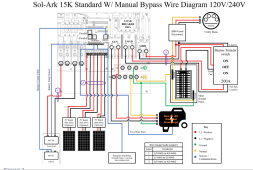ImAnIdiotPleaseBePatient
Solar Enthusiast
- Joined
- Dec 10, 2022
- Messages
- 421
Don't have a house quite yet for the solar build, but I'm putting together my parts list so I can get started when I get the keys. All I have to offer is my parts list and a picture of my unfinished home ?
Parts list so far with est pricing:
TOTAL SOLAR PARTS LIST
BIG STUFF:
Solark 15k x2 $17200
18650batterystore batterys (catl302ah x 96, jbd16s x6, bms breaker x 6) $11505
Qcell Q.PEAK DUO ML-G10+ x64 $10000
PVkit2.0 racking $4200
DC BATTERY
4/0 15 feet black, 15 red, lugs $216
1/0 25 black 25 red might need a little more, no lugs $175
bluesea 1000 amp busbar need two of these and covers $600
AC SYSTEM
siemens 200 amp double throw transfer switch $1090
polaris 2 in 1 out =< 4/0 need six $240
2/0 wire in and out of solark prob 20' each color $200
4/0 service entrance cable 25' $245
48" wireway x 2 if i can join them $590
PV System
red wire 10 gauge solar $400
180' of 1 1/4 emt $360
Guesswork connectors for emt $360
PVKIT gripperfit, PVKIT2.0 etc

TOOLS
4/0 hydraulic crimper $87
ferrule crimper with ferrules $40
klein crimper for bms ring terminals $40
klein wire strippers $34
ratcheting cable cutter $130
mc4 removal tool $10
Extra mc4 connectors $22
4/0 lugs $25
1/0 lugs $15
Before tax credit = $49655
After tax credit = $34758
Hopefully I have a roof soon! I will keep this updated as I confirm small details like "why did I order this" and "why did china accept my international wire and not send me the stuff" and as the price hastily begins to climb. Trying to do this mostly to code, but Florida has this pesky rule that you have to be a "eelectricul contraktor" or something like that, so it will be off grid with a little assist from the grid. I feel like I have learned enough here to take the plunge, so I started really trying to plan it out a little better. Looking forward to warmer weather and a new project. Thanks everyone here for answering all my questions. If you have any tips, or any of the equipment looks like the wrong choice, I am all ears. A few things here and there will not be to spec, but I am trying to hit 95% or so.


Parts list so far with est pricing:
TOTAL SOLAR PARTS LIST
BIG STUFF:
Solark 15k x2 $17200
18650batterystore batterys (catl302ah x 96, jbd16s x6, bms breaker x 6) $11505
Qcell Q.PEAK DUO ML-G10+ x64 $10000
PVkit2.0 racking $4200
DC BATTERY
4/0 15 feet black, 15 red, lugs $216
1/0 25 black 25 red might need a little more, no lugs $175
bluesea 1000 amp busbar need two of these and covers $600
AC SYSTEM
siemens 200 amp double throw transfer switch $1090
polaris 2 in 1 out =< 4/0 need six $240
2/0 wire in and out of solark prob 20' each color $200
4/0 service entrance cable 25' $245
48" wireway x 2 if i can join them $590
PV System
red wire 10 gauge solar $400
180' of 1 1/4 emt $360
Guesswork connectors for emt $360
PVKIT gripperfit, PVKIT2.0 etc
TOOLS
4/0 hydraulic crimper $87
ferrule crimper with ferrules $40
klein crimper for bms ring terminals $40
klein wire strippers $34
ratcheting cable cutter $130
mc4 removal tool $10
Extra mc4 connectors $22
4/0 lugs $25
1/0 lugs $15
Before tax credit = $49655
After tax credit = $34758
Hopefully I have a roof soon! I will keep this updated as I confirm small details like "why did I order this" and "why did china accept my international wire and not send me the stuff" and as the price hastily begins to climb. Trying to do this mostly to code, but Florida has this pesky rule that you have to be a "eelectricul contraktor" or something like that, so it will be off grid with a little assist from the grid. I feel like I have learned enough here to take the plunge, so I started really trying to plan it out a little better. Looking forward to warmer weather and a new project. Thanks everyone here for answering all my questions. If you have any tips, or any of the equipment looks like the wrong choice, I am all ears. A few things here and there will not be to spec, but I am trying to hit 95% or so.





